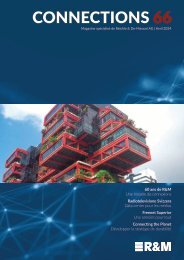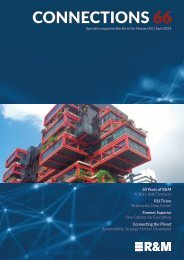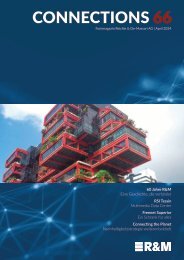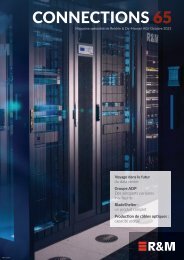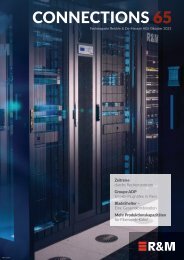CONNECTIONS_55-e
R&M customer magazine, Connectivity, Cabling, Fiber Optica, Copper
R&M customer magazine, Connectivity, Cabling, Fiber Optica, Copper
You also want an ePaper? Increase the reach of your titles
YUMPU automatically turns print PDFs into web optimized ePapers that Google loves.
Trends<br />
Time<br />
for 400G<br />
050.6670<br />
Fiber-optic signal transmission is reaching a new dimension: 400 Gigabits per<br />
second. The subject dominated the specialist OFC 2018 congress in San Diego.<br />
400G chips will be commercially available from the end of 2018.<br />
The Optical Fiber Communication Conference<br />
and Exhibition (OFC) has once again<br />
broken a record. This year, 15,500 experts<br />
traveled to the conference to swap stories<br />
on their experience with technologies for<br />
the fastest possible data transmission. The<br />
R&M Innovation Team was also present to<br />
find out about new and upcoming high tech<br />
developments which will then immediately be<br />
incorporated in innovation planning.<br />
The general consensus of opinion at the OFC<br />
2018 was: The time has come for 400 Gigabit/s.<br />
This will give data centers the opportunity<br />
to work even faster than they are working<br />
now. A further focal point was the launch of 5G<br />
services which will require a massive extension<br />
Deployed Coherent Bandwidth by Speed<br />
% Total Bandwidth Deployed<br />
100 %<br />
050.6672<br />
75 %<br />
50 %<br />
25 %<br />
0 %<br />
of FO networks both in expanses and between<br />
the base stations and antennas.<br />
The OFC exhibitors presented a wide range<br />
of 400G chips, components and modules<br />
which will soon be available commercially.<br />
There are basically three formats which will<br />
be competing against one another, supported<br />
by well-known manufacturer groups (multi<br />
source agreements, MSA).<br />
The two market-ready transceiver formats<br />
– QSFP-DD and OSFP – are the logical<br />
continuation of conventional connectivity<br />
with plug-in, active connectors on the front<br />
panel of a switch. Frequency, modulation<br />
and transmission speed will increase, the<br />
2014 2015 2016 2017 2018 2019 2020<br />
2021<br />
100G 200G 400G Source: Cignal AI, Optical Applications Report<br />
form factor is becoming more compact,<br />
energy consumption will fall in comparison<br />
to common transceivers used to date. The<br />
QSFP-DD concept is currently seen as the<br />
clear leader on the way to 400G.<br />
COBO chooses a new path<br />
The COBO consortium is proposing an even<br />
more radical change. The COBO concept<br />
envisages the plug-in transceiver module<br />
moving to the main board. The copper path<br />
between electronics and interface will thus<br />
be greatly reduced. The modules are likely<br />
to transmit 400 Gbit/s or 800 Gbit/s. Small,<br />
passive fiber-optic connectors take on the<br />
connection function in the front panel.<br />
The consortium led by Microsoft published<br />
a first specification for COBO connectors at<br />
the OFC.<br />
050.6231<br />
Dr. Blanca Ruíz<br />
Innovation Project Manager<br />
blanca.ruiz@rdm.com<br />
10 10I2018–<strong>55</strong> <strong>CONNECTIONS</strong>










